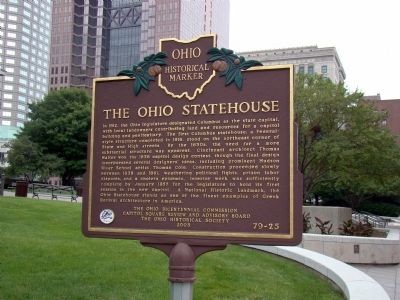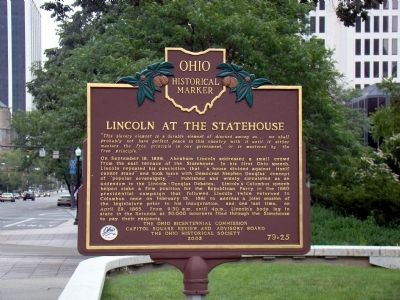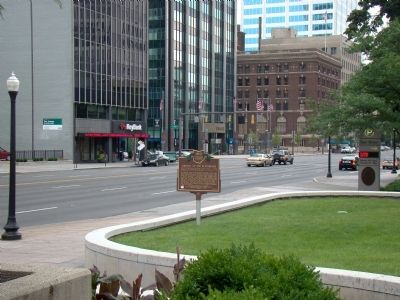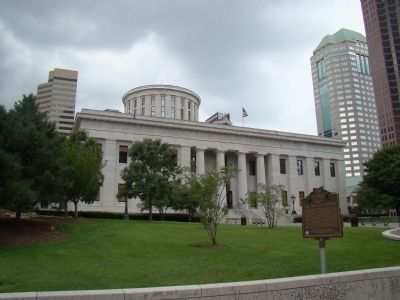Uptown District in Columbus in Franklin County, Ohio — The American Midwest (Great Lakes)
The Ohio Statehouse / Lincoln at the Statehouse
Lincoln at the Statehouse. “This slavery element is a durable element of discord among us... we shall probably not have perfect peace in this country with it until it either masters the free principle in our government, or is mastered by the free principle.”
On September 16, 1859, Abraham Lincoln addressed a small crowd from the east terrace of the Statehouse. In his first Ohio speech, Lincoln repeated his conviction that “a house divided against itself cannot stand” and took issue with Democrat Stephen Douglas’ concept of “popular sovereignty.” Published and widely circulated as an addendum to the Lincoln-Douglas Debates, Lincoln’s Columbus speech helped stake a firm position for the Republican Party in the 1860 presidential campaign that followed. Lincoln twice returned to Columbus: once on February 13, 1861 to address a joint session of the legislature prior to his inauguration, and one last time, on April 29, 1865. From 9:30 a.m. until 4 p.m., Lincoln’s body lay in state in the Rotunda as 50,000 mourners filed through the Statehouse to pay their respects.
Erected 2003 by The Ohio Bicentennial Commission, Capital Square Review and Advisory Baord, and The Ohio Historical Society. (Marker Number 79-25.)
Topics and series. This historical marker is listed in this topic list: War, US Civil. In addition, it is included in the Former U.S. Presidents: #16 Abraham Lincoln, the Lincoln 1861 Inaugural Train Stops, and the Ohio Historical Society / The Ohio History Connection series lists. A significant historical month for this entry is January 1857.
Location. 39° 57.733′ N, 82° 59.937′ W. Marker is in Columbus, Ohio, in Franklin County. It is in the Uptown District. Marker is on Broad Street (U.S. 40) east of High Street, on the right when traveling east. Touch for map. Marker is in this post office area: Columbus OH 43215, United States of America. Touch for directions.
Other nearby markers. At least 12 other markers are within walking distance of this marker. Ohio Statehouse Sesquincentennial (a few steps from this marker); Liberty Tree (a few steps from this marker); Peace (within shouting distance of this marker); Replica of Sun Dial at Mount Vernon (within shouting distance of this marker); James A. Rhodes (within shouting distance of this marker); William B. Saxbe
(within shouting distance of this marker); The Underground Railroad / Black Conductors of Columbus (within shouting distance of this marker); Trinity Episcopal Church (within shouting distance of this marker); POW/MIA Walls (within shouting distance of this marker); “These Are My Jewels” (about 300 feet away, measured in a direct line); Here Stood Lincoln (about 300 feet away); Ohio World War Memorial (about 300 feet away). Touch for a list and map of all markers in Columbus.
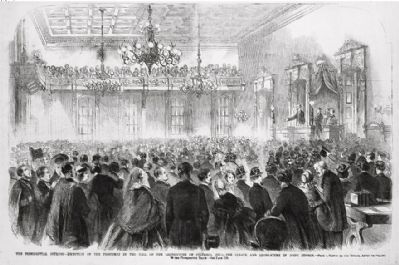
Photographed By Frank Leslie's Illustrated Newspaper, circa March 2, 1861
5. The Presidential Journey - reception of the President in the hall of the Legislature…
The Presidential Journey - reception of the President in the hall of the Legislature of Columbus, Ohio- the Senate and Legislature in joint session. Image courtesy of the Library of Congress. (Click on picture to enlarge.)
Credits. This page was last revised on February 3, 2023. It was originally submitted on August 5, 2008, by J. J. Prats of Powell, Ohio. This page has been viewed 2,834 times since then and 33 times this year. Photos: 1, 2, 3, 4. submitted on August 5, 2008, by J. J. Prats of Powell, Ohio. 5. submitted on November 29, 2014.
